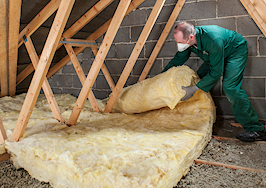Are your clothes are still damp and wrinkly after hours in the dryer? Before driving to the nearest Home Depot and spending a few hundred dollars on a new dryer, there may be another culprit to blame — an old and neglected dryer vent.
“A good sign that your dryer vent is clogged and needs to be cleaned is that your clothes will start taking longer to dry,” certified master inspector Cord Werner told Inman in 2018. “I actually have a friend where his kids thought their dryer was messed up, so they bought another dryer, and it wasn’t working either. What they found out was that their dryer vent was clogged up.”
Beyond damp and wrinkly clothing, a humid laundry room and excess lint around the dryer are telltale signs that your dryer vent needs to be cleaned or replaced. Also, depending on where the dryer vent vents out (e.g. on the side of your home instead of the roof), you may be able to see excess dust and lint blocking the opening.
“Run your hand along the top of the dryer and washer, nearby shelves, and other items in the room,” a Flamingo Appliances explainer read. “If your hand comes back linty, that’s a sign that linty dryer exhaust is being released into the room.”
“If you clean a surface and it’s linty after the next time you run the dryer, then your dryer is leaking exhaust for sure,” it added. “Your duct may be ripped, open, or not installed at all.”
Lastly, you may notice the absence of a dryer vent altogether. Either way, it’s best to call a professional to clean or replace your existing vent or install a new one.
Homeowners should expect to spend between $100 to $200 for dryer vent cleaning, which should be scheduled alongside annual HVAC maintenance. Replacing or installing a dryer vent can cost as little as $80 or as much as $1,000 depending on materials, labor, and if the vent needs to be routed through the roof.
According to HomeAdvisor, the majority of the cost comes from labor ($20 to $25 an hour) whereas the metal dryer vent and vent kit, which includes the transition duct, clamps, and wall sleeve, usually costs no more than $60. However, the cost can quickly balloon if the vent needs to be moved or rerouted to the exterior — something that can set you back an extra $1,000, minus any wall repairs from cutting.
Werner also said homeowners must budget for other problems that may arise from unkempt or improperly installed vents, such as mildew and rot, or a booster for vents that open on the roof.
“That’s a hard one to say because it varies,” he said of fixing mildew damage. “It depends on how long it’s been going on and how frequently the dryer is being used. If the attic has good ventilation, [the amount of damage] isn’t horrible.
“But especially in the garage, mildew can easily spread across the wall,” he added. “If that’s the case, then you’ll have to think about cutting [parts of the wall out] and replacing it.”
If the vent needs to be rerouted through the roof, then homeowners will need to budget for the cost of a booster fan ($150 to $250) to make sure the lint and moisture are properly expelled.
“You can vent out the roof, which is becoming a more common practice,” Werner said. “There are length requirements on that, where it’s 35 feet max. But when you start adding elbows, which are turns in the vent, it’s more like 25 feet.”
“Each 90-degree turn in the vent is equivalent to 5 feet, and each 45-degree turn is equivalent to 2.5 feet, so you have to account for those [turns] too,” he added. “If it’s too long, you’ll have to install a booster fan that has a pressure sensor on it.”
Once the dryer vent is replaced or installed, most experts recommend homeowners have their dryer vent cleaned every one to two years alongside their HVAC maintenance, after they move into a new home, or anytime they complete a renovation as the dust and debris can be get caught in the vent.
Werner said homeowners can do also do a DIY cleaning if their vent opens on the side of their home, which would require them to simply disconnect the vent, clean it and reattach it.
“The [sidewall] vent is usually only a foot or two long, and they can disconnect it, wipe it out, and reconnect it,” he explained. “If your duct is metal, it will last for a very long time.”













